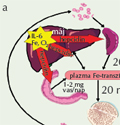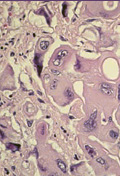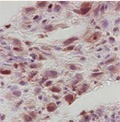The eLitMed.hu medical portal uses computer cookies for convenient operation. Detailed information can be found in the Cookie-policy.
Lege Artis Medicinae - 2009;19(03)
Content
[Anaemia of chronic disease: causes and therapeutic options]
[Anemia observed in patients with infectious, inflammatory, or neoplastic diseases and persisting for more than one month is called anemia of chronic disease. The term anemia of chronic disease is far from perfect, the terms of anemia of inflammation, cytokine-mediated anemia, and anemia of defective iron reuse are also used. Anemia of chronic disease is more common than any other anemia syndrome - apart from anemia caused by iron deficiency secondary to blood loss. Erythrocytes usually are normocytic, but hypochromia and microcytosis may also be observed. In almost every case, this type of anemia is hypo-regenerative. Characteristic laboratory findings include hypoferremia, hyperferritinemia, and hypotransferrinemia. Cause of this anemia is complex; pathogenesis of this anemia includes moderate shortening of erythrocyte survival, blunted response to erythropoietin, reduced medullar erythropoiesis, and limited medullar iron availability. In addition to treating the underlying pathology, treatment opportunities are recombinant human erythropoietin, transfusions, and intravenous iron.]
[A holistic approach to neuropathic pain]
[Neuropathic pain is a chronic pain disorder due to a primary lesion and/or dysfunction of the peripheral or central nervous system. This tormenting condition causes a lot of distress to the patients, impairs their quality of life, and demands significant expenses. Chronic neuropathic pain is frequently under-diagnosed and mistreated. Explanations for these problems are the complex underlying pathomechanism, variability of symptoms, difficulties in diagnosis, and the differences between the treatment of this and other painful disorders. In addition, comorbid conditions such as anxiety, depression, and sleep disorders are often overlooked. Apart from the diagnostic difficulties, also treatment is usually unsatisfactory. Frequently NSAIDs are used, but they are usually not effective. Undoubtedly, even with the use of evidence-based treatment - such as duloxetine and pregabalin - complete pain relief is not always possible. Lack of proper medical education also contributes to problems in diagnosis and treatment. In western countries, diabetes is the most common cause of polyneuropathy. Painful diabetic neuropathy is the most intensely studied neuropathic pain condition; a lot of evidence comes from randomized controlled trials of this type of neuropathy. The same drugs as in the case of other neuropathic pain conditions are used for the symptomatic treatment of painful diabetic neuropathy. Etiological therapy is based on the best achievable glycemic control. A combination of etiological and symptomatic therapy can be a future treatment, but proving this will require further studies.]
[Metastatic tumour with papillary structure in the colon]
[INTRODUCTION - Colorectal carcinomas are frequent and their diagnosis and treatment is generally considered a routine task in oncology, but in some cases, using a routine approach may cause unforeseeable difficulties. CASE REPORT - A 72-year-old woman underwent segmental bowel resection of a tumour diagnosed as colon cancer 15 months earlier. The tumour also metastasized in the lungs. Autopsy findings raised a high level of suspicion that her colon tumour was a metastasis from a uterine cervical adenocarcinoma undiscovered before the post mortem examination. CONCLUSION - Occasionally metastases do not arise from the tumour that we are aware of, and metastases may mimic primary tumours. Although the papillary structure of a colon cancer should raise the possibility of a metastatic nature, also primary - at least partially - papillary carcinomas may arise in the large intestines.]
[Intimal sarcoma of the pulmonary artery]
[INTRODUCTION - Malignant tumours arising from the wall of the pulmonary artery or the aorta are very rare. Two types are known, leiomyosarcoma and intimal sarcoma. Intimal sarcoma is usually associated with a thrombus that may close the lumen, which complication being important in case of pulmonary artery tumours. Such tumours can be diagnosed by magnetic resonance imaging (MRI). CASE REPORT - A 42-year-old woman was hospitalized with an anamnesis of three months of subfebrility/fever, dyspnea and hemoptysis. Right-sided pulmonary thromboembolism and exudative pleuritis were diagnosed. MRI findings suggested a tumour of the right pulmonary trunk. She underwent surgery with extracorporeal circulation; and a compact mass with a connected thrombus filling the right pulmonary trunk and its hilar branches were removed by thromboendarterectomy. Histology revealed intimal sarcoma of the pulmonary artery. The patient died of this tumour’s progression four years later. CONCLUSION - In case of pulmonary thromboembolism the possibility of intimal sarcoma has to be considered. Vascular tumours can be proven or excluded by MRI.]
1.
Clinical Neuroscience
Is there any difference in mortality rates of atrial fibrillation detected before or after ischemic stroke?2.
Clinical Neuroscience
Factors influencing the level of stigma in Parkinson’s disease in western Turkey3.
Clinical Neuroscience
Neuropathic pain and mood disorders in earthquake survivors with peripheral nerve injuries4.
Journal of Nursing Theory and Practice
[Correlations of Sarcopenia, Frailty, Falls and Social Isolation – A Literature Review in the Light of Swedish Statistics]5.
Clinical Neuroscience
[Comparison of pain intensity measurements among patients with low-back pain]1.
Clinical Neuroscience Proceedings
[A Magyar Stroke Társaság XVIII. Kongresszusa és a Magyar Neuroszonológiai Társaság XV. Konferenciája. Absztraktfüzet]2.
3.
Journal of Nursing Theory and Practice
[A selection of the entries submitted to the literary contest "Honorable mission: the joys and challenges of our profession" ]4.
Journal of Nursing Theory and Practice
[End of Life and Palliative Care of Newborns in the Nursing Context]5.
Journal of Nursing Theory and Practice
[Aspects of Occupational Health Nursing for Incurable Patients ]




















